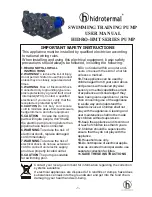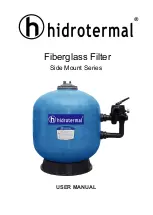
11
INSTRUCTION AND MAINTENANCE MANUAL
IMPORTANT CONSIDERATIONS
Pressure filters must only be operated by qualified personnel. Operators must
have received training in the tasks involved in operating the filter, and be informed
of the dangers and harm that it can entail.
•
Use a pressure gauge panel to control the filter pressure.
•
The operating pressure of the filter must never exceed the maximum pressures
recommended in the technical data.
•
Pressurised containers cannot withstand negative internal pressures, therefore
the appropriate measures must be taken when installing them to avoid this
situation.
•
It is recommended to use equipment with a maximum allowable pressure 20%
higher than the maximum pressure that the equipment will need to operate
under.
•
Never connect the filter directly to the water supply, as the pressure from the
mains always exceeds the maximum pressure tolerated by the filter.
•
Always bleed the air from the inside of the filter before starting the cycle.
•
The pressure differential between the inlet and outlet connections must never
exceed 1.0 bar. A higher difference in pressure than that could damage the
collector or the nozzle plate.
•
The cleaning process should never exceed the maximum operating pressure of
the filter.
•
When using air for cleaning, the internal pressure must not exceed 1.0 bar. Use
a blower, and never a compressor, to inject air into the filter.
•
The operating temperature range must be kept to at all times. The minimum
operating temperature for all of the filters is 1°C. The maximum operating
temperature is 40°C.
•
In filters that have been treated for contact with ozone (O3), the maximum
concentration of O3 must never exceed 2ppm. The standard filters are not
suitable for contact with ozone.
•
The filters must be installed in a way that allows maintenance, repair and
testing tasks to be carried out easily and correctly. Install the filter with the
identification label visible, and keep this identification.






























